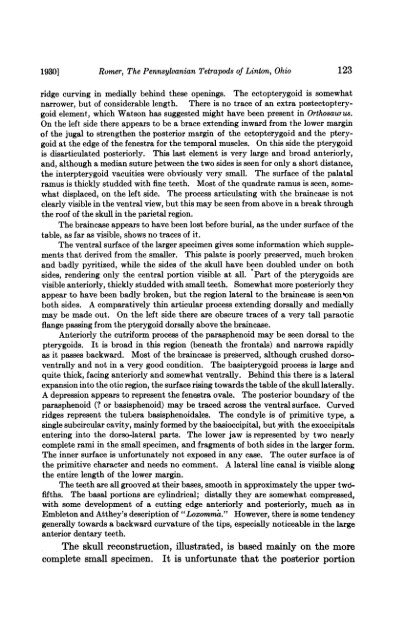View/Open - American Museum of Natural History
View/Open - American Museum of Natural History
View/Open - American Museum of Natural History
Create successful ePaper yourself
Turn your PDF publications into a flip-book with our unique Google optimized e-Paper software.
19301<br />
Romer, The Pennsylvanian T'etrapods <strong>of</strong> Linton, Ohio<br />
123<br />
ridge curving in medially behind these openings. The ectopterygoid is somewhat<br />
narrower, but <strong>of</strong> considerable length. There is no trace <strong>of</strong> an extra postectopterygoid<br />
element, which Watson has suggested might have been present in Orthosaurus.<br />
On the left side there appears to be a brace extending inward from the lower margin<br />
<strong>of</strong> the jugal to strengthen the posterior margin <strong>of</strong> the ectopterygoid and the pterygoid<br />
at the edge <strong>of</strong> the fenestra for the temporal muscles. On this side the pterygoid<br />
is disarticulated posteriorly. This last element is very large and broad anteriorly,<br />
and, although a median suture between the two sides is seen for only a short distance,<br />
the interpterygoid vacuities were obviously very small. The surface <strong>of</strong> the palatal<br />
ramus is thickly studded with fine teeth. Most <strong>of</strong> the quadrate ramus is seen, somewhat<br />
displaced, on the left side. The process articulating with the braincase is not<br />
clearly visible in the ventral view, but this may be seen from above in a break through<br />
the ro<strong>of</strong> <strong>of</strong> the skull in the parietal region.<br />
The braincase appears to have been lost before burial, as the under surface <strong>of</strong> the<br />
table, as far as visible, shows no traces <strong>of</strong> it.<br />
The ventral surface <strong>of</strong> the larger specimen gives some information which supplements<br />
that derived from the smaller. This palate is poorly preserved, much broken<br />
and badly pyritized, while the sides <strong>of</strong> the skull have been doubled under on both<br />
sides, rendering only the central portion visible at all. Part <strong>of</strong> the pterygoids are<br />
visible anteriorly, thickly studded with small teeth. Somewhat more posteriorly they<br />
appear to have been badly broken, but the region lateral to the braincase is seenton<br />
both sides. A comparatively thin articular process extending dorsally and medially<br />
may be made out. On the left side there are obscure traces <strong>of</strong> a very tall paraotic<br />
flange passing from the pterygoid dorsally above the braincase.<br />
Anteriorly the cutriform process <strong>of</strong> the parasphenoid may be seen dorsal to the<br />
pterygoids. It is broad in this region (beneath the frontals) and narrows rapidly<br />
as it passes backward. Most <strong>of</strong> the braincase is preserved, although crushed dorsoventrally<br />
and not in a very good condition. The basipterygoid process is large and<br />
quite thick, facing anteriorly and somewhat ventrally. Behind this there is a lateral<br />
expansion into the otic region, the surface rising towards the table <strong>of</strong> the skull laterally.<br />
A depression appears to represent the fenestra ovale. The posterior boundary <strong>of</strong> the<br />
parasphenoid (? or basisphenoid) may be traced across the ventral surface. Curved<br />
ridges represent the tubera basisphenoidales. The condyle is <strong>of</strong> primitive type, a<br />
single subcircular cavity, mainly formed by the basioccipital, but with the exoccipitals<br />
entering into the dorso-lateral parts. The lower jaw is represented by two nearly<br />
complete rami in the small specimen, and fragments <strong>of</strong> both sides in the larger form.<br />
The inner surface is unfortunately not exposed in any case. The outer surface is <strong>of</strong><br />
the primitive character and needs no comment. A lateral line canal is visible along<br />
the entire length <strong>of</strong> the lower margin.<br />
The teeth are all grooved at their bases, smooth in approximately the upper tw<strong>of</strong>ifths.<br />
The basal portions are cylindrical; distally they are somewhat compressed,<br />
with some development <strong>of</strong> a cutting edge anteriorly and posteriorly, much as in<br />
Embleton and Atthey's description <strong>of</strong> "Loxomma." However, there is some tendency<br />
generally towards a backward curvature <strong>of</strong> the tips, especially noticeable in the large<br />
anterior dentary teeth.<br />
The skull reconstruction, illustrated, is based mainly on the more<br />
complete small specimen. It is unfortunate that the posterior portion
















